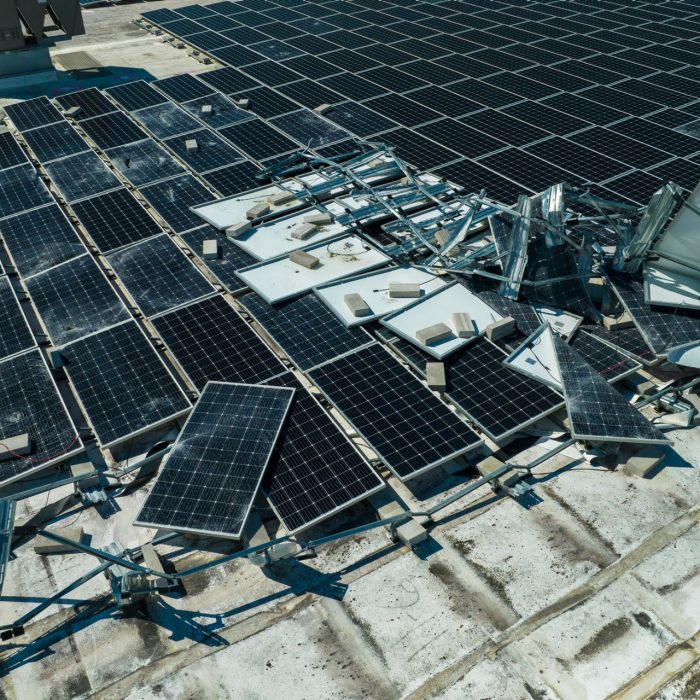Professor Yansong Shen
A new beginning for end-of-life solar panels

With the installation of solar panels both domestically and commercially only set to rise in the coming years, new focus has been placed on the importance of appropriate panel recycling. Now, a team at UNSW chemical engineering have developed a more effective way of recycling solar panels through a process with more than 95% recycling efficiency, which helps to recover valuable materials including silver, copper, glass and silicon. Not only is this process set to keep millions of future panels out of landfill – the technology enables the upcycling of panel materials for an array of purposes and industries.
Led by Professor Yansong Shen, the interdisciplinary team of metallurgy, PV, catalysis and water treatment experts has transformed Australia’s solar recycling conundrum through the development of a customised pyrometallurgy-sieving-hydrometallurgy process, which improves the way materials from photovoltaic panels can be separated and extracted for reuse. Until recently, doing so has been a significant challenge as individual parts are typically integrated in a solar panel in a way that makes them hard to separate.
The new technology, which has already been patented, is a particularly important solution given first-generation panels from the early 1990s are now nearing their end-of-life expectancy. “While you might only have 20-40 panels on your rooftop – in remote areas we have many solar farms and every government is trying to install more,” explains Prof. Shen.
“The more we care for these old panels now, the better. If we don’t treat them well, they’ll become very harmful rubbish for all of us including next generations.”
This act of care involves recycling and extracting old materials for new uses. “These panels are not rubbish, they’re raw materials,” he says. In taking this approach, the aim is to solve a number of fundamental problems and avoid a landfill disaster. “In Europe, you can’t add solar panels to landfill anymore – and locally, in Victoria, it’s banned,” explains Prof. Shen.
“In Queensland and NSW, we’re already talking about the need to ban solar panels from landfill, so there really is a social urgency needed to deal with this problem – the volume of incoming panels is huge.”
Professor Yansong Shen working on-site at his UNSW lab. Image credit: Richard Freeman
The start of something big
The work was initially inspired by Prof. Shen’s own experience of seeing his neighbours removing their old solar panels. “I kept wondering – where do they go now?” he says. “It’s clear we need to find a more suitable place for them.”
He then realised the process of recycling the panels, at that time, was extremely basic. “These recycling businesses were really just logistical – they’d collect the panels from a rooftop and transport them to a warehouse where they then get stored,” he explains. “But a warehouse is limited in capacity – one day these warehouses will be full, what do we do then?”
Prof. Shen and his team took this problem into their own hands in 2019 by generating basic research outcomes. The importance and benefits of their research quickly became clear to others. Funding flowed from ARENA, the NSW Environmental Protection Authority and the Australian Research Council. “When we started this project, we produced the outcomes very quickly because we understood the industry need and developed them based on our well-established expertise in metallurgy – my background, which shares the same nature of solar panel recycling in metal extraction. In this angle, the silver and copper recovered from the end-of-life solar panel are also “green metals” he explains. “We’ve been working with several industry partners throughout the whole supply chain – from the very upstream industry partners to downstream partners as well.”
The research has since been recognised by various organisations and solar farms both locally and abroad, with Prof. Shen and his team now having collaborated with top industry partners such as Jinko, Trina Solar and top recycling industries in Australia such as VISY Recycling, PV Industries, ReNew Materials, Solarec. “We work with solar farms, solar panel recycling industries and the top three solar panel manufacturers in the world,” he says.
One man’s trash is another man’s treasure
Treating and separating the panel materials effectively provides an opportunity to reuse each material in new manufacturing processes. This is particularly true of silicon. “In the very beginning we hoped to recycle the silicon and reuse it in new solar panel manufacturing, but we realised it was going to be quite expensive and thus not practical,” says Prof. Shen. Instead, the team pivoted to use silicon for other industries. “For example, in the steel industries, they use silicon in their processes and can be the potential end users,” says Prof. Shen. This is just one of many examples of how his work is enabling other industries and organisations to benefit from reusing panel materials or learn to better repurpose their own.
Professor Yansong Shen has developed a more effective way of recycling solar panels – ensuring they avoid landfill and can instead be salvaged for an array of valuable materials. Image credit: Richard Freeman
A future of possibilities
Prof. Shen hopes his work will turn into a new Australian export that can be distributed to Europe and Asia, and ultimately provide global impact for many years to come. “This is a lifetime job – trying to make it workable for the whole world,” he explains. “We really need to develop this technology from first generation to the second generation and to the third generation.”
While the next five years may involve plenty of hard grit and determination, the ongoing potential impact of his research is not lost on Prof. Shen. “Knowing that what I’m working on is meaningful and useful helps me feel like myself – my energy is back.”
Share this story
Energy
Read more
Get in touch and see what’s possible.
Ask how we can help your business, industry, or market through collaboration.



